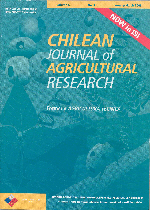
|
Agricultura Técnica
Instituto de Investigaciones Agropecuarias, INIA
ISSN: 0365-2807
EISSN: 0365-2807
Vol. 63, No. 3, 2003, pp. 277-286
|
 Bioline Code: at03031
Bioline Code: at03031
Full paper language: Spanish
Document type: Research Article
Document available free of charge
|
|
|
Agricultura Técnica, Vol. 63, No. 3, 2003, pp. 277-286
| en |
Effect of Water Stress Applied at Different Development Periods of Grapevines cv. Chardonnay on Production and Wine Quality
Ferreyra, Raúl E.; Sellés, Gabriel V.; Ruiz, Rafael S. & Sellés, Iván M.
Abstract
During growing seasons 1998/99, 1999/2000 and 2000/01 a field trial on grapevines (Vinis vinifera L.) cv. Chardonnay was carried out with the objective of evaluating the effects of water stress on yield, wine quality, plant water status and nutritional reserves in the roots. The following treatments were applied: T1 and T2, application of water equivalent to 100% and 40%, respectively, of crop evapotranspiration (ETc) for the entire season; T3, no irrigation from bud formation to veraison and irrigation at 100% of ETc from then to harvest; T4, irrigation at 100% of ETc from bud formation to veraison and no irrigation from then to harvest. Water shortage significantly decreased shoot growth and berry diameter, which resulted in yield reduction. The growing period from bud formation to veraison had the largest reductions of these variables. On the other hand, the water deficit induced a decrease of carbohydrate reserves of the root system. Total acidity, global wine quality and phenols present in the wine did not increase with water stress, different behavior than that observed in red wines. The stem water potential (SWP), measured at noon, was a good indicator of plant water stress. Grapevines not submitted to water stress had SWP of over -0.8 Mpa, while those plants under water stress had values of -1.2 MPa.
Keywords
water use efficiency, Vitis vinifera, regulated irrigation deficit
|
| |
| es |
Efecto del Estrés Hídrico Aplicado en Distintos Periodos de Desarrollo de la vid cv. Chardonnay en la Producción y Calidad del Vino
Ferreyra, Raúl E.; Sellés, Gabriel V.; Ruiz, Rafael S. & Sellés, Iván M.
Resumen
Durante las temporadas 1998/99, 1999/2000 y 2000/01 se realizó una investigación en vides (Vitis vinifera L.) cv. Chardonnay, con el objeto de evaluar los efectos de la restricción hídrica sobre la producción, calidad del vino, estado hídrico de las plantas y las reservas nutricionales de las raíces. Los tratamientos aplicados fueron los siguientes: T1 y T2, aplicación de agua equivalente al 100 y 40%, respectivamente, de la evapotranspiración del cultivo (ETc) durante toda la temporada; T3, sin aplicación de agua desde brotación a pinta y reposición del 100% de ETc de pinta hasta la cosecha; T4, aplicación de agua equivalente al 100% de ETc entre brotación y pinta, y suspensión del riego desde pinta hasta la cosecha. La disminución del aporte hídrico redujo en forma significativa el crecimiento de brotes y el diámetro de bayas, lo que se tradujo en una disminución del rendimiento. El período comprendido entre brotación y pinta determinó las mayores disminuciones de estas variables. Por otra parte, el déficit hídrico produjo un descenso en los carbohidratos de reserva del sistema radicular. La acidez total, la calidad global del vino y los fenoles presentes en el mosto, a diferencia de lo observado en vinos tintos, no aumentaron con los déficit hídricos. El potencial hídrico xilemático (SWP) medido a mediodía, fue un indicador adecuado del estado hídrico de las plantas. Las vides no sometidas a estrés hídrico presentaron SWP superiores a - 0,8 MPa, en tanto que las sometidas a déficit hídrico presentaron valores de -1,2 MPa.
Palabras-clave
eficiencia del uso de agua, Vitis vinifera, riego deficitario controlado
|
| |
© Copyright 2003 - Instituto de Investigaciones Agropecuarias, INIA (Chile). Full-text articles also available online at http://www.inia.cl/at/agritec.htm
Alternative site location: http://www.inia.cl/at/agritec.htm
|
|
